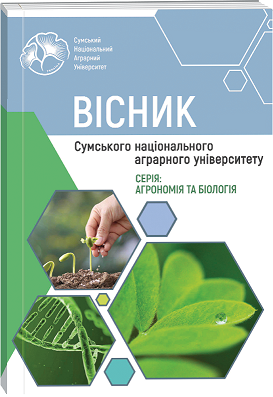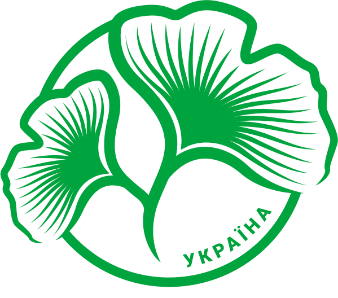INHERITANCE OF RESISTANCE TO RACE F OF BROOMRAPE (OROBANCHE CUMANA WALLR.) BY SUNFLOWER (HELIANTHUS ANNUUS L.)
Abstract
Genetic protection is a key component in the control measures against the plant – parasite of sunflower, broomrape (Orobanche cumana Wallr.). Studies of the genetics of resistance of domestic breeding sunflower materials to virulent broomrape races, which are widespread in Ukraine, are not sufficiently presented in the literature; therefore, developments in this direction are of particular importance. The article presents the results of researches on the detection of the peculiarities of the inheritance of sunflower resistance to broomrape in the first and second hybrid generations from crossing lines with various levels of resistance. The study was conducted in the scientific crop rotation fields of the Yuriev Plant Production Institute of NAAS in 2021–2023 and in an experimental greenhouse of the Institute. Broomrape infestation of plants was determined visually by counting healthy nodules of the parasite on the roots of the studied plants. It was repeated three times. The damage degree is expressed as the mean number of nodules per one assessed plant. In an experimental greenhouse, it was determined that the parental lines differed in resistance to broomrape. Lines– pollen fertility restorers, Kh 1814 V, Kh 1817 V, and KhZU 10 V were resistant to a broomrape population, whose seeds were collected in significantly damaged sunflower fields in the Kharkivska Oblast. The most virulent race in the broomrape population was defined as race F. No more than one nodule of the parasite was observed on the affected plants of these lines. For crossing broomrape-resistant lines Kh 85 V and Kh 808 V on a fertile basis, F1 hybrid combinations had 0.11– 1.13 nodules of the parasite per one tested plant, and the number of nodules on one affected plant did not exceed four nodules. Susceptible plants with 5 and more than 5 nodules were observed in all studied F2 populations with a segregation of 15 resistant plants: 1 susceptible plant.
References
2. Akhtouch, B., Muñoz-Ruz, J., Melero-Vara, J., Fernández-Martínez, J., & Dominguez, J. (2002). Inheritance of resistance to race F of broomrape in sunflower lines of different origins. Plant Breeding, 121 (3), 266–268. doi: 10.1046/j.1439-0523.2002.00701.x
3. Akhtouch, B., Del Moral, L., Leon, A., Velasco, L., Fernández-Mart́ınez, J. M., & Pérez-Vich, B. (2016). Genetic study of recessive broomrape resistance in sunflower. Euphytica, 209, 419–428. doi: 10.1007/s10681-016-1652-z
4. Auriac, M. C., Griffiths, C., Robin-Soriano, A., Legendre, A., Boniface, M. C., Muños, S., Fournier, J., & Chabaud, M. (2024). The penetration of sunflower root tissues by the parasitic plant Orobanche cumana Wallr. is intracellular. New Phytologist, 241, 2326–2332. doi: 10.1101/2023.07.24.550254
5. Baytar, A. A., Celik, I., Doganlar, C., Frary, A., & Doganlar, S. (2021). QTL mapping of broomrape (Orobanche cumana Wallr.) resistance in sunflower (Helianthus annuus L.) using GBS-SNPS. Turkish J. Field Crop, 26, 157–162. doi: 10.17557/tjfc.940409
6. Beil, G. M., & Atkins, R. E. (1965). Inheritance of quantitative characters in grain sorghum. Iowa State Journal, 39 (3), 345–348.
7. Burlov, V. V., & Burlov, V. V. (2010). Efektyvnist heniv or u zabezpechenni stiikosti soniashnyku do novykh ras vovchka (Orobanche cumana Wallr.). [Efficiency of or genes in ensuring resistance of sunflower to new races of broomrape (Orobanche cumana Wallr.)]. Selektsiia i nasinnytstvo., 98, 28–37.
8. Calderón-González, Á., Pérez-Vich, B., Pouilly, N., Boniface, M C., Louarn, J., Velasco, L., & Muños, S. (2023). Association mapping for broomrape resistance in sunflower. Frontiers in Plant Science, 13, 1–20. doi: 10.3389/fpls.2022.1056231
9. Chuiko, D. V., Ponomarova, M. S., & Brahin, O. M. (2021). Ekonomichna efektyvnist vyroshchuvannia linii, hibrydiv ta sortiv soniashnyku zalezhno vid rehuliatora rostu roslyn [Economic efficiency of growing sunflower lines, hybrids and varieties depending on plant growth regulator]. Visnyk Kharkivskoho natsionalnoho ahrarnoho universytetu im. V.V. Dokuchaieva. Seriia «Ekonomichny nauky», 2 (1), 197–208. (in Ukrainian). doi: 10.31359/2312-3427-2021-2-1-197
10. Cvejić, S., Radanović, A., Dedić, B., Jocković, M., Jocić, S., & Miladinović, D. (2020). Genetic and genomic tools in sunflower breeding for broomrape resistance. Genes, 11 (2), 152, 1–17. doi: 10.3390/genes11020152
11. Domіnguez, J. (1996). R-41, a sunflower restorer inbred line, carrying two genes for resistance against a highly virulent Spanish population of Orobanche cernua. Plant Breeding, 115, 203–204. doi: 10.1111/j.1439-0523.1996.tb00904.x
12. En-Nahli, Y., Hejjaoui, K., Mentag, R., Es-Safi, N. E., & Amri, M. (2023). Large field screening for resistance to broomrape (Orobanche crenata Forsk.) in a global lentil diversity panel (GLDP) (Lens culinaris Medik.). Plants (Basel), 12, 2064. doi: 10.3390/plants12102064
13. Fernández-Aparicio, M., Masi, M., Cimmino, A., & Evidente, A. (2021). Effects of benzoquinones on radicles of Orobanche and Phelipanche Species. Plants (Basel), 10, 746. doi: 10.3390/plants10040746
14. Genovese, C., D’Angeli, F., Attanasio. F., Caserta, G., Scarpaci, K. S., & Nicolosi, D. (2021). Phytochemical composition and biological activities of Orobanche crenata Forssk.: a review. Nat. Prod. Res., 35, 4579–4595. doi: 10.1080/14786419.2020.1739042
15. Griffing, B. (1950). Analysis of quantitative gene-action by constant parent regression and related techniques. Genetics, 35(3), 303−321. doi: 10.1093/genetics/35.3.303
16. Hosni, T., Abbes, Z., Abaza, L., Medimagh, S., Salah, H. B., & Kharrat, M. (2020). Effect of broomrape (Orobanche cumana Wallr.) on some agro-morphological and biochemical traits of Tunisian and some reference sunflower (Helianthus annuus L.) accessions. Journal of Plant Diseases and Protection, 127, 831–841. doi:10.1007/s41348-020-00362-6
17. Imerovski, I., Dedić, B., Cvejić, S., Miladinović, D., Jocić, S., Owens, G. L., Tubić, N. K., Rieseberg, L. H. (2019). BSA-seq mapping reveals major QTL for broomrape resistance in four sunflower lines. Mol. Breeding, 39, 41. doi: 10.1007/s11032- 019-0948-9
18. Imerovski, I., Dimitrijević, A., Miladinović, D., Dedić, B., Jocić, S., Tubić, N. K., & Cvejić, S. (2016). Mapping of a new gene for resistance to broomrape races higher than F. Euphytica, 209, 281–289. doi: 10.1007/s10681-015-1597-7
19. Ish-Shalom-Gordon, N., Jacobsohn, R., & Cohen, Y. (1993). Inheritance of resistance to Orobanche cumana in sunflower. Phytopathology. 83. 1250–1252.
20. Kaundun, Sh. Sh., Martin-Sanz, A., Rodrıguez, M., Serbanoiu, T., Moreno,J., Mcindoe, E., & le Goupil, G. (2024). First case of evolved herbicide resistance in the holoparasite sunflower broomrape, Orobanche cumana Wallr. Front. Plant Sci., 15, 1–10. doi: /10.3389/fpls.2024.1420009
21. Khablak, S. H., & Spychak, V. M. (2023). Orobanche cumana Wallr. in crops Heliаnthus annuus. Bulletin of Sumy National Agrarian University. The Series: Agronomy and Biology, 54, 4. 62–67. doi: 10.32782/agrobio.2023.4.9
22. Kurylych, D. V., & Makliak, K. M. (2022). Peculiarities of the sunflower breeding for resistance to broomrape (Orobanche cumana Wallr.). Selektsiia i nasinnytstvo, 122, 19–29. doi: 10.30835/2413-7510.2022.271748.
23. Mutuku, J.M., Cui, S., Yoshida, S., & Shirasu, K. (2021). Orobanchaceae parasite–host interactions. New Phytol., 230, 46–59. doi: 10.1111/nph.17083
24. Pérez-Vich, B., Akhtouch, B., Muñoz-Ruz, J., Fernández-Martínez, J. M., & Jan, C. C. (2002). Inheritance of resistance to a highly virulent race “F” of Orobanche cumana Wallr. in a sunflower line derived from interspecific amphiploids. Helia. 25. 137–144. doi: 10.2298/HEL0236137P
25. Pinkovskyi, H V., & Tanchyk, S. P. (2020). Produktyvnist ta ekonomichna efektyvnist vyroshchuvannia soniashnyku zalezhno vid strokiv sivby ta hustoty stoiannia roslyn u Pravoberezhnomu Stepu Ukrainy [Productivity and economic efficiency of growing sunflower depending on the sowing time and plant density in the Right-Bank Steppe of Ukraine]. Agrobiology, 2, 115–123. (in Ukrainian). doi: 10.33245/2310-9270-2020-161-2-115-123
26. Roy, D. (2012). Biometrical genetics: analysis of quantitative variation. Alpha Science, 2.8.
27. Sisou, D., Tadmor, Y., Plakhine, D., Ziadna, H., Hübner, S., & Eizenberg, H. (2021). Biological and transcriptomic characterization of pre-haustorial resistance to sunflower broomrape (Orobanche cumana W.) in sunflowers (Helianthus annuus). Plants, 10, 1810. doi: 10.3390/plants10091810
28. Solodenko, A.Ye. (2011). Otsinka stiikosti soniashnyku de vovchka rasy C za dopomohoiu molekuliarnykh markeriv [Estimation of sunflower resistance to broomrape race C with using of molecular markers]. Visnyk Kharkivskoho natsionalnoho ahrarnoho universytetu im. V.V. Dokuchaieva. Seriia “Biolohiia”, 3(24), 61–66. (in Ukrainian).
29. Sukno, S., Melero-Vara, J. M., & Fernández-Martínez, J. M. (1999). Inheritance of resistance to Orobanche cernua Loefl. in six sunflower lines. Crop Sci, 39 (3), 674–678. doi: 10.2135/cropsci1999.0011183X003900020011x
30. Sydiakina, O. V., & Hamaiunova, V. V. (2023). Suchasnyi stan i perspektyvy vyrobnytstva nasinnia soniashnyku [Current state and prospects for production of sunflower seeds]. Tavriiskyi naukovyi visnyk, 131, 196–204. doi: 10.32782/2226-0099.2023.131.25 (in Ukrainian)
31. Velasco, L., Perez-Vich, B., Jan, C. C., & Fernandez-Martіnez, J. M. (2007). Inheritance of resistance to broomrape (Orobanche cumana Wallr.) race F in a sunflower line derived from wild sunflower species. Plant Breeding, 126, 67–71. doi: 10.1111/j.1439-0523.2006.01278.x

 ISSN
ISSN  ISSN
ISSN 



